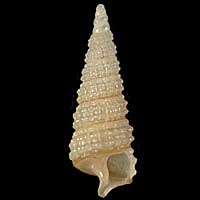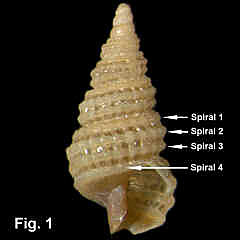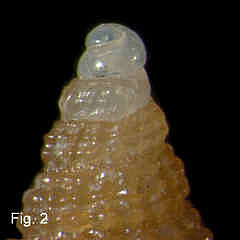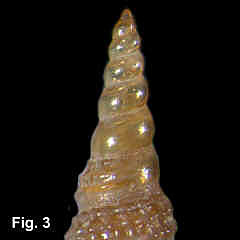|
< Previous family introduction |
|
|||||
|
|
Family Cerithiopsidae Cerithiopsids
|
|||||
|
The Cerithiopsidae is a family of minute to small dextrally-coiled gastropods, closely related to the sinistrally-coiled Triphoridae. Cerithiopsids have a world-wide distribution, occurring from the arctic to the tropics and from the intertidal to c. 3000 m (Marshall, 1978). In the same paper Marshall reported that the family contained at least 400 described species, but two recent publications on the family in the Philippines (Cecalupo & Perugia, 2011) and Vanuatu (Cecalupo & Perugia, 2013) have added 262 species. Cerithiopsids are common but poorly documented in tropical Australia; 32 species have been named from NSW, but there is probably that number again of undescribed species. Cerithiopsids feed on sponges. They have developed a long proboscis to allow the mouth to reach down into the sponge, and the radula has been modified to suit this method of feeding. In NSW specimens are uncommonly found alive, but they are not uncommon as empty shells in beach washup. In a large proportion of species there is a multi-whorled protoconch, 3 or 4 whorls being common, with one species having a protoconch of 6 whorls.. The protoconch is important for identification, as there is a large number of species which have similar teleoconchs and are difficult to identify without it. The family is poorly known in NSW. The small size, infrequent occurrence and dependence on the protoconch for identification makes the group difficult to study, and it was not documented until Laseron published his revision in 1951. In that study he dealt with 6 named species and erected 32 new ones. With the named species he was faced with the difficulty of not having access to types or sufficiently detailed type descriptions, and was unable to identify them adequately. He appeared to be working with only a small number of specimens of each species, sometimes only one or two, with limited microscope magnification, and was not able to take much account of protoconch detail or variation in shell sculpture. He set aside type specimens for the species he erected, but some are without protoconchs, and in a few cases the syntypes are of different species. Unfortunately, although he seems to have had a range of material available for some species, this has not been preserved in the Museum collection, and in most cases a holotype or syntypes is the only material available. A search of the large quantity of unidentified material in the Museum collection found more examples of some species, but much more material with good protoconchs is needed to make more progress. In his first paper on the family in 1951 Laseron did not attempt to place the species into genera, but in his 1956 paper he erected new genera and went back and allocated the NSW species within these. He based his genera on shell morphology and the number of whorls in the protoconch, but the limits of his genera are not clear, and a classification based on more fundamental characters is needed. This was commenced by Marshall (1978), in his revision of the family in New Zealand, where he reported on Tubercliopsis infracolor (Laseron, 1951), which occurs in NSW and New Zealand. After considering animal morphology, the protoconch, operculum and radula he erected a new genus for it; this course will most likely apply to most NSW species when closely studied. In this work I have mainly used the names from Laseron's 1956 paper, not because I think they are the best for the species but to refrain from confusing the classification further. Laseron was unable to identify some of the species that were named before his work in 1951, and his treatment of these is problematical. Particularly, for the species Seila atkinsoni (Tenison-Woods, 1876) and Seila crocea (Angas, 1871) I have used an earlier name to Laseron. Family References Cecalupo, A. & Perugia, I. 2011. Family Cerithiopsidae H. Adams & A. Adams, 1853 in the Central Philippines. Quaderni 30:1-262. Cecalupo, A. & Perugia, I. 2013. The Cerithiopsidae (Caenogastropoda: Triphoroidea) of Espiritu Santo Vanuatu. 253 pp. Published by the authors: Milano. Cotton , B.C. 1951. Australian Recent and Tertiary Mollusca, family Cerithiopsidae. Records of the South Australian Museum 9:383-396. Laseron, C.F. 1951. Revision of the New South Wales Cerithiopsidae. The Australian Zoologist 11(4): 351-368. Laseron, C.F. 1956. The Family Cerithiopsidae (Mollusca) from the Solanderian and Damperian zoogeographical provinces. Australian Journal of Marine and Freshwater Research 7:151-182. Marshall, B.A. 1978. Cerithiopsidae (Mollusca: Gastropoda) of New Zealand, and a provisional classification of the family. New Zealand Journal of Zoology 5:47-120. Identification Notes The shell character common to all the Cerithiopsidae is the sculpture of three, or occasionally four, spiral cords on each teleoconch whorl, with an extra spiral revealed on the last whorl (Fig. 1). In species with three exposed spirals on each whorl spiral 4 is hidden by the following whorl and is exposed only on the last whorl. Some species have an additional spiral on the base, referred to as spiral 5. In the genus Seila the cords are smooth, but in the other genera there are axial ribs which make beads at the intersections with the spirals. Shell shape is generally long and narrow, of 5 to 15 whorls, but in Joculator the shells are bulbous and of only 4 or 5 whorls. The protoconch may be paucispiral (Fig. 2) or multispiral up to 6 whorls (Fig. 3). The base is usually concave. Most species are brown, with a few being white or fawn. The most common combination is an elongate shell with beaded whorls and a protoconch of 2-4 whorls. Shell size is given as:
Coverage All known named species from NSW are detailed here, these being, with a few modifications, the species itemised by Laseron (1951). But as mentioned above there are many undescribed species, probably more than are actually named. A few problematic species are listed below: Cerithiopsis angasi Semper, 1874
Cerithiopsis gregaria Laseron, 1951
Cerithiopsis cylindrica (Watson, 1886)
|



